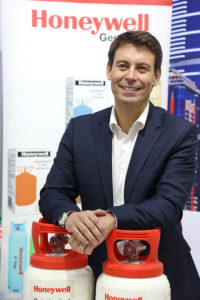George Koutsaftes, President, Advanced Materials, Performance Materials and Technologies; Julien Soulet, Vice President and General Manager, Fluorine Products, EMEA and Advanced Materials, Middle East, Turkey and Africa (META) and Amir Naqvi, Regional Business Leader, Honeywell Fluorine Products, META, provide an overview of the global adoption of refrigerants and how manufacturers are moving to future-proof their equipment. Excerpts from the interview with Hannah Jo Uy…
Could you provide us with an overview of the adoption of refrigerants in the GCC region? How would you gauge the uptake of new-generation refrigerants and level of investment among regional manufacturers compared to other regions?
Koutsaftes: Overall, energy-efficiency standards are primarily driving technological development in the GCC region for both equipment and refrigerants. Because of that, you are seeing the GCC region countries accelerate and close the gap in technological adoption. I actually expect they may surpass some regions. That’s a big-picture point. Everything starts with energy efficiency. What that means is that equipment designed under old refrigerant technology is also old efficiency design. For an equipment manufacturer to design a new set of equipment to meet the energy efficiency standards, they don’t want to do it more than once, but they want to make sure it’s compliant with current and upcoming regulations and energy-efficiency standards, in conjunction with HFOs or other low-global warming refrigerants. What we are seeing, as a result, is that not only is equipment design providing efficiency, but so are refrigerants. There has been a lot of evidence in installations of Solstice ze chillers in Europe – over 50 OEM customers, who included Solstice ze chillers in their product portfolio and actively sell them in Europe, where the data we are getting on refrigerants is providing an equal amount of efficiency as the equipment itself. [For] Solstice zd, the adoption is led here in the Middle East. It is produced for low-pressure centrifugal chillers, which by design are more efficient than medium-pressure. With Trane and others adopting Solstice zd, they are upgrading equipment design to meet needs for climate change and really developing a piece of equipment 10-15% more energy efficient than the next-best chiller available in the market, with the same capacity. In Saudi Arabia, energy efficiency is driving equipment manufacturers to work together to provide best-in-class solutions. Not only does that mean energy efficiency, it also means being Kigali-compliant.
Naqvi: Saudi Arabia and United Arab Emirates take a leadership role. But we have had interesting discussions in Bahrain. Kuwait is very interesting in terms of energy-efficiency specs for high-ambient conditions; they even conduct testing at 52 degrees C, from what I learnt. When we talk about HFO adoption, you have Solstice zd chiller installations in United Arab Emirates, Saudi Arabia, Egypt, Kuwait and Oman. There have been Solstice ze installations in Bahrain, so it’s across the region.
Soulet: An important element is that producers are winning projects across the region with HFOs. They are showing energy-efficiency savings. Most of these technologies are fully commercial; they have been launched, proven and used already in Europe. In Europe, it’s up to the building owners to require the energy-efficiency levels and specifications. Regulators in United Arab Emirates and Saudi Arabia are including high energy-efficiency standards. Just looking at return of investment, this makes a lot of sense over the lifetime of the chiller. More than 90% of a chiller’s cost is the electricity consumption in its lifetime.

George Koutsaftes, President, Advanced Materials, Performance Materials and Technologies
Could you give an update on what is happening on the ground in the United States? Has the drive for energy efficiency been enough to encourage manufacturers to opt for more environmentally friendly refrigerants, even in the absence of regulations or lax regulations? How does it fare compared to Europe?
Koutsaftes: In the United States, we have energy-efficiency standards driving technological development standards of OEMs, but they are waiting in the wings for direction on what the regulations are telling them from a refrigerant point of view. They don’t want to do this twice; they want to do it once and be done with it and, therefore, companies like Honeywell are helping drive a decision around a federal mandate at US EPA level or at the state level. Led by the legislative momentum in California, states like New York, Connecticut, Vermont, Maryland and Washington have announced their intention to take actions that require the phase-out of high-GWP HFCs. [In Europe] the F-gas phase down has helped the acceleration of adoption. Like supermarkets, roughly speaking, more than 30% of them in Europe have transitioned to some low-GWP refrigerant. It’s almost the same number in the US because of the energy-efficiency benefit and long-term cost. Back to Europe, you see this chiller wave. We estimate that by 2021, 50% of chillers will have transitioned out to a low-GWP solution. In the US, we think the industry is galvanising; in 2023 and 2025 you can start to see the second wave of adoption, once these rules are in place.
Soulet: Europe is at the forefront. Take the example of chillers, based on the work happening to meet European regulations – all the major chiller manufacturers have adopted HFO 1234-ZE as a next-generation refrigerant. The industry has looked at the solution, the safety and the performance, total cost-benefit and environmental benefit and decided this is the best solution for that specific application. Adoption will take place globally, based on performance and environmental regulations, but just performance will also drive it.

Julien Soulet, Vice President and General Manager, Fluorine Products, EMEA and Advanced Materials, META
What of opportunities in other markets? What are the company’s activities in Africa, and are countries, such as Iraq, in view of its rehabilitation efforts, emerging as potentially attractive markets?
Koutsaftes: We haven’t had projects in Iraq yet, but it’s something we have been talking about. We think Honeywell could be well positioned, ready and prepared for it. We are most active in South Africa. We think South Africa is at the cusp of emerging, and there is more adoption as they push for it. If you use energy efficiency as a way to save the country money and to lower consumption, you put yourself into the bullseye of HFO solutions available.
Naqvi: In Africa, in Egypt there is a lot of activity going on in the new capital with Solstice zd-based chillers. Some OEMs are winning with HFO-based chillers in Egypt. On the insulation side, a lot of companies manufacturing water heaters and refrigerators need to improve their energy-efficiency performance, and the most cost-effective to doing it is through improving the insulation performance by adopting Solstice LBA as a blowing agent for the foam. Therefore, the two, South Africa and Egypt, are the key markets for us. We are doing work in South Africa and if you look at the region’s supermarket segment, South African industry is very mature and we see a lot of traction and interest in our smart refrigeration system as well as HFObased Solstice N40 to drive efficiency.

Amir Naqvi, Regional Business Leader, Honeywell Fluorine Products, Middle East, Turkey and Africa (META)
What is the update on Solstice N41? Are plans to commercialise the product still on track? And how is the level of interest from manufacturers?
Koutsaftes: Energy-efficiency standards are really driving acceleration for adoption of best-in-class technology in HFOs. It’s going to be a regional focus for us. We talked about Solstice ze and zd energy efficiency gains in installations in the regions in Europe – the proof cases in Europe will go here. We are already in dialogue with manufacturers. Solstice N41 is another key development to replace R410-A. It’s A1 and the first non-flammable and reduced-GWP refrigerant in the market place that has comparable, if not better performance, in capacity and when it comes to energy efficiency in a high-ambient region. Data roughly has five per cent energy benefits using Solstice N41. We are on active tests with 15 OEMs globally for variable refrigerant flow (VRF) applications and US-style unitary applications. We have done performance testing with OEMs and material compatibility testing. We expect to do a soft launch of the product towards the end of this year for a demonstration, so customers can see. This is being driven by OEMs in Asia, Europe and the United States, and we think the development of these units by Asian manufacturers will likely be supplied here in the Middle East.
Naqvi: There has been a lot of interest from local OEMs, who have started to evaluate. There has been extreme interest from OEMs for the value and performance, especially at high-ambient conditions, and it is not flammable, making it the key driver for interest for local industry.
Hannah Jo Uy is Assistant Editor at Climate Control Middle East magazine. She may be contacted at hannah@cpi-industry.com
Copyright © 2006-2025 - CPI Industry. All rights reserved.